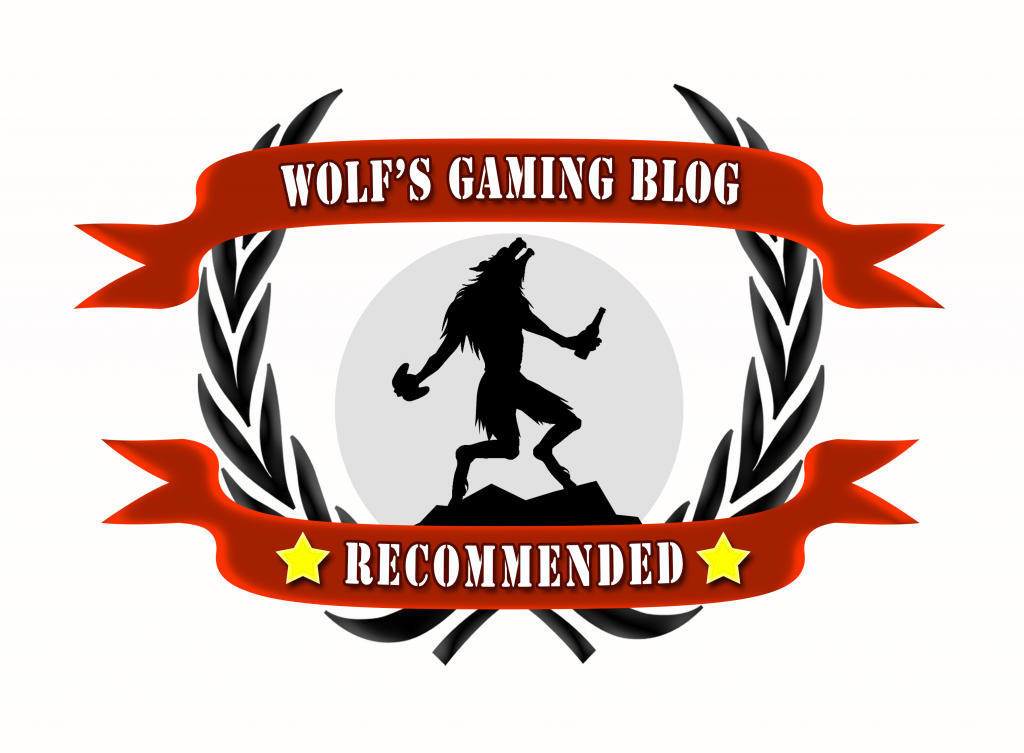Massive. Daunting. Difficult. Deep. Complex. Time-consuming. Confusing. Rewarding. Satisfying. Slog. These are just a small selection of the words that could be used to describe Pathfinder: Wrath of the Righteous. This mammoth RPG is based on the pen and paper Pathfinder system, and is a sequel to Pathfinder: Kingmaker, a game I’m sad to say I missed. I’m sad to say it because if Wrath of the Righteous is anything to go by, I missed something special. While it does have some issues, there’s no doubt that Owlcat have forged something awesome.
But I haven’t completed it. I need to provide the proper context for the several thousands sprawling words I’ve spent trying to give you an idea of what Pathfinder: Wrath of the Righteous is all about. At the time of writing I’ve sunk about 50-hours into the game, and I’m staring down the barrel of anywhere between 20-60 more. The truth is I don’t want to play it to the end. That isn’t because it’s a bad game, it’s just after 40-hours I’m not sure I want to sit for another 20-60 more. It would be weeks before I would be able to get a review out, and a game like this shouldn’t be played at a breakneck speed. But I also want to move onto other things, review other things, talk about other things, and eventually I’ll get back around to Wrath of the Righteous. So, as we get this review underway, just keep in mind I’m not talking as someone with nearly a hundred hours under their belt.
The first boss battle in Pathfinder is the character creation screen, a daunting challenger that may take hours to defeat and possibly a calculator. Visual customization is weak, probably because you barely ever see your character up close, but everything else is a dazzling array of stats, classes, feats, abilities and spells so dense it might make you feel like you’re back at school. There’s something in the region of 25 character classes to choose from, and they can be mixed and matched, and each of those have an array of skills and feats that come with them. There’s a bunch of preset characters that come with handy ratings indicating their difficulty, and I think for most people I’d recommend going down this route, at least for the first few hours or even the first playthrough. With so much to choose from and no context of how the game actually plays, rolling your own custom character can be both satisfying and incredibly dangerous. Without any context for how the game works, it’s very possible to end up with a build that simply doesn’t work.
Available On: PC
Reviewed On: PC
Developed By: Owlcat Games
Published By: META Publishing
This creation system gives you an idea of what the rest of the game is going to be like. Massive, deep and also so densely packed that it sometimes trips over yourself. There are heaps and heaps of options for crafting your character, but a lot of the classes and feats are also kind of…well, superfluous. A lot of things overlap, a lot of classes are just objectively less useful than others, many of the abilities and classes could have been combined and so on. Is Wrath of the Righteous better for having so many things to choose from? It’s hard to say. Other games probably would have streamlined the whole thing because more is not always better. Yet, I can’t knock the amount of room you get for flavour. There’s heaps of ways to shape exactly who you want to be in those menus, and that might be worth the trade-off.
The levelling up of your creation and your party of adventurers is just as deep and nuanced. You tend to gain levels more slowly than in other, faster paced games, but each time you do there’s plenty to tinker with. Classes can be levelled up further, or you can start mixing classes, turning your Tiefling Cleric into a bloodthirsty berserker with healing spells. Then there are skills to consider, feats to choose, spells to learn. If that wasn’t enough there’s the Mythic levels to consider, turning your custom character into a sort of demi-god, replete with awesome powers that come with their own walls of complex text and stats. You can evolve into an Angel for the forces of good, a Demon or even a Trickster who can, and I’m not making this up, summon a murder pony or even fire fish at people. Or you can opt to remain a boring mortal if you fancy a much bigger challenge. I wouldn’t recommend it, though, because, because the Mythic paths are one of the coolest aspects of the entire game, and Owlcraft do an excellent job of granting you heaps of power without unbalancing everything. Plus, murder pony.
And while Wrath of the Righteous does take everything quite seriously, there’s plenty of room for oddity. You can have animal companions, for example, like a dinosaur or a horse. Hell, my horse, named Bob, turned out to be one of the best fighters in my party and actually ended up delivering the killing blow to numerous, big bosses while my actual main character lay bleeding out on the floor. At one point, I made a dexterity check to climb a ladder onto the roof of a house, and wound up with Bob the horse and the rest of the party crowded onto the roof. How did Bob even get up there? I have no idea.
The game opens with your unconscious body being taken into a friendly town that’s in the middle of having a rather nice looking party. Clearly, you already aren’t having the best day. Things quickly go from shit to shit-infested garbage heap when a massive flying demon and his personal army of arseholes crash the party. Aside from not having an invite this demonic dick makes another terrible faux pas by murdering the townspeople, as well as the ancient dragon/human that guards the place. You wind up underground after a huge crack appears across the city, and the adventure begins here. Before long a couple of handy companions are found, and then you stumble across some mythic power that translates to you being the chosen one who is going to save the day via the power of dice rolls, dialogue options and copious party management!
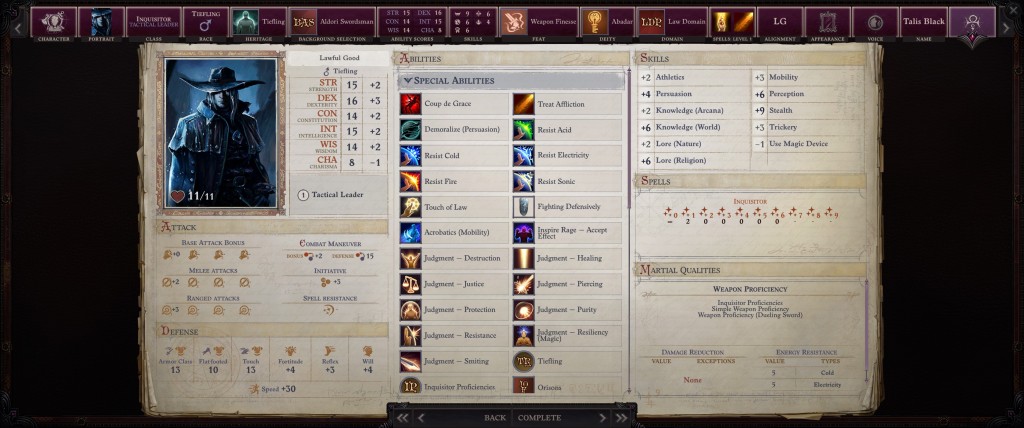
As setups for a grand fantasy campaign go it’s practically being crushed to death by a big, fat cliché, but that’s okay. This is a classic hero story set in a fascinating world packed full of lore. As a complete newbie to Pathfinder (both the pen and paper version, and the prior videogames) I went in worried that I would struggle to comprehend everything. I was partially right – there’s a lot going on in Wrath of the Righteous, and keeping up can be a challenge at times. Handily, though, the developers have made it so a lot of names and other things that appear during dialogue can be hovered over to to trigger a pop-up filled with information so that you can immerse yourself in the world. Or you can ignore it all, play for 70-hours, build an awesome character and still don’t know what’s going on or why that thing over there just happened.
The writing isn’t the sharpest or the most engaging, but there sure is a lot of it. This is a game that will easily consume your life, taking anywhere from 40-100 hours to complete. There’s even partial voice acting, which is impressive for a game of this size working on a fairly small budget. It’s reserved for the bigger moments and main story beats, but it’s surprisingly good. The writing wavers a bit from being fine to being a little odd, like it was run through Google translate, and I admit to skipping a lot of the big walls of dialogue because the prose wasn’t grabbing me. But for the most part, I was invested in what was going on, and enjoyed some of the twists, turns and inevitable betrayals.
The real meat of the story, at least in my view, are your companions. Strewn across the game like human candy are twelve recruitable chums, coming in a variety of flavours and textures. The first you run into is Seelah, a former street urchin and thief who dragged herself up by her bootstraps and became a Paladin. She’s abundantly cheerful, and immediately fits the role of your squad’s tank. From there you start finding some…stranger folk, like Lann, the mongrel archer who looks half human and half dragon/lizard thing. There’s Ember, the odd elf who was burned at the stake for being a witch, leaving her with burnt flesh. She’s childlike in many ways, and her insights and comments about the world are almost always fascinating. Camellia is a rather high and mighty character, acting aloof and hiding one hell of a secret that resolves in one of the best storylines in the whole game. Then there’s Nenio, a crazy scientist; Wolfjiff, the cocky thief; Daeran, the asshole noble who takes great delight in being a complete twat to everyone; Regill, the goth gnome and even a succubus.
This ragtag group of miscreants, witches and nutcases are more than enough to keep you playing even if the main story starts to drag or isn’t grabbing your attention. They all have their own quest lines that are more than worth going out of the way to complete. I just wish they had more dialogue options between quests, sort of like Mass Effect where you could drop by and dig a little deeper. It’s more spread out in Wrath of the Righteous, so I frequently found myself not directly talking to companions for long stretches of time. They don’t banter outside of resting, either, although they do add comments and jump into conversations, sometimes changing things a fair bit. But whenever I did finally get to properly interact with them it was always worth the wait. Ultimately, these people grew to feel like friends and family, and their stories were the highlight of the whole game.
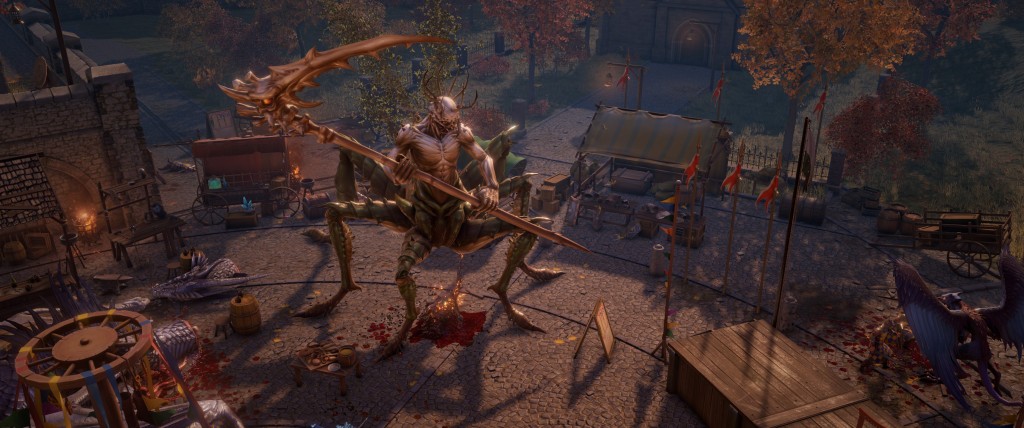
Core to the game’s experience is how everything is handled by dice rolls, be it in combat where you roll to hit, to damage, to cast spells and to evade attacks, or outside of fights where you roll for knowledge checks or to lift objects or persuade characters.
I won’t call all the dice rolling a flaw because, after all, it’s central to Pathfinder. It’s a pen and paper RPG that uses D&D as its foundation, so throwing dice is more common than idiots in pub. What I will say is that it can make for an incredibly frustrating experience at times, and for certain people it could be a deal breaker. There are going to be times when you charge into a group of Cultists and get utterly demolished by a series of terrible rolls that leave multiple party members heavily wounded or just plain dead. There’s going to be times when one of your character spends like 6 turns trying to get to their feet after slipping on a conjured puddle of grease. It frequently left me cursing the Gods and yelling at the screen. On the flipside, sometimes Lady Lucky will bestow her blessing and you breeze through everything with excellent rolls, making a trip to the casino or a lottery ticket seem like a smart thing. If you’ve ever known the pain and pleasure of XCOM games then you’ll know the highs and lows that Pathfinder suffers from.
There’s a lot of fighting to be done in Wrath of the Righteous. In fact, I’d almost argue too much fighting because over the course of the mammoth campaign I did begin contemplating what it would be like to travel more than 100ft without running into zombies, demons, undead bear things, cultists and angry gnomes. Combat offers the option to swap between turn-based and real-time at the press of a button, a feature I really love. For new players, especially those who find the various stats and dice rolls confusing, turn-based is the perfect choice because it lets them analyse the combat log in the corner of the screen, providing a way to figure exactly what is happening. It also lets you more carefully consider your moves and abilities.
Keep in mind, though, turn-based combat does massively increase the length of the game. It can turn small fights into quite long affairs. As for the bigger battles…well, during an early one at Defender’s Heart it took me nearly an hour, whereas in real-time it took about 10-minutes in real-time.
Speaking of real-time, it can be a lot of fun but tricky to manage if you don’t have all your abilities, scrolls and potions memorised. Even the toughest party members can go down fast, and making use of powers like Charge is a lot harder. In the end, I used a mix of real-time for the small, simple fights and turn-based for everything else. Honestly, turn-based just feels right in a game like this, and is truer to the pen and paper roots.
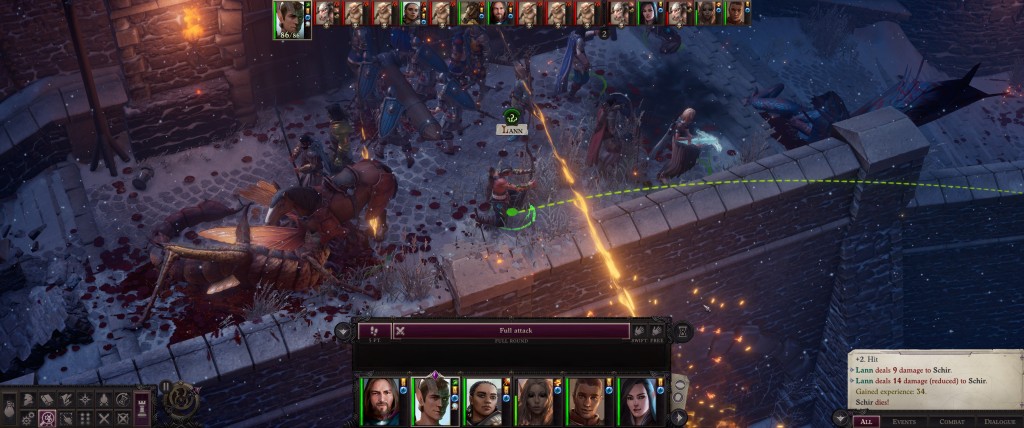
Assuming you’re an intelligent and witty person who correctly chose turn-based combat, on each character’s turn you can typically move and take one main action, like casting a spell, smacking someone with a mace or bestowing a blessing on the whole party. Some complications are added via attacks of opportunity which let characters potentially land a free hit on an enemy moving pass them, and flanking, which is when a character is outnumbered and takes extra damage. As you would imagine, then, combat is about getting your main fighters into the fray while your spellcasters and ranged companions chill at the back and unleash on the enemy.
This is a tough game, so buffing your party prior to entering new areas or ahead of fights is vital. Before long you’ll develop a routine, casting numerous spells, chugging potions and using scrolls to ensure your party are at their very best. Many of the best spells and abilities, though, are limited to a few uses per day, and to get them back you need to rest, which is also one of the most basic ways of removing various debuffs that your party may be suffering from. Naturally, this is a system that could be abused, so you can’t just set up camp anywhere. When you do roll out the sleeping bags, there are some choices to make such as who is going to perform the protective rituals to potentially reduce the creeping corruption, whose going to cook a decent meal and who is going to stand guard.
The CRPG aspects of Wrath of the Righteous are great, and I was having so much fun adventuring through the world and levelling up my party. There are so many cool quests to check out, and while there isn’t a lot of loot to find, the stuff you do get tends to be quite exciting. Weapons, armour and other things are common, but only some of them offer much of a bonus, so when you do stumble across something that has an awesome ability or something like +4 resistance it’s more of a big deal. But there’s a big element of the game I don’t like and that’s Crusades. Basically, after a while you’re handed control of entire armies because obviously as the chosen one there could be no better choice to lead the fight. With this new command comes a sort of Heroes of Might & Magic Lite gameplay mode where new troops must be purchased from town, armies need to be marched around and battles must be fought on a turn-based grid.
On paper the idea does sound sort of cool, bringing a whole new set of mechanics into an already deep RPG. In practice, though, it’s just really bloody boring. The turn-based battles are slow and clumsy, the armies move at an infuriating slow pace across the world and none of the decisions about army composition or which generals to assign feel all that interesting. All it seems to do is get in the way of adventuring, although you still do that anyway, controlling your little party separately from the armies. It’s a bit odd that the supreme commander spends damn near no time at all with his actual armies and is instead to be found wandering around a cave somewhere, picking up shiny objects and yelling at his companion who has just failed their 3rd roll to jump over a little gap. But ultimately the biggest problem I had is that most fights just came down to stacks of units slowly chipping away at each other long after it has become clear who the victor will be.
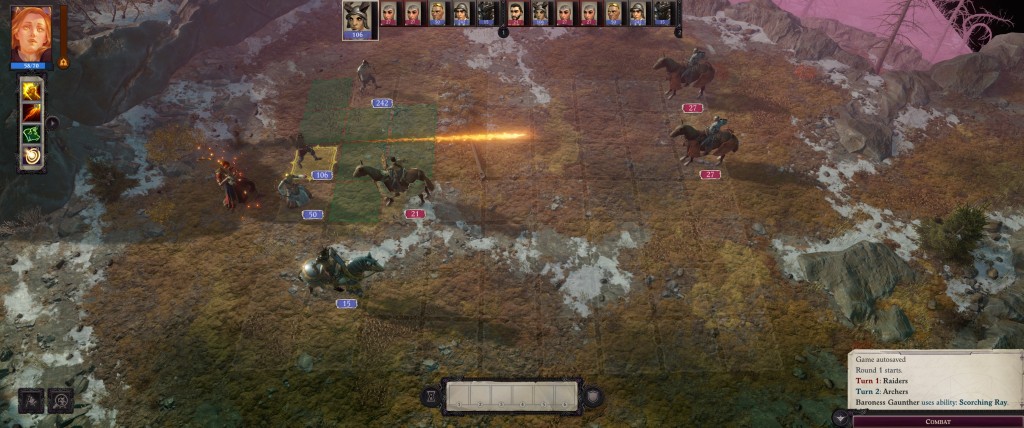
But to the developer’s supreme credit it seems they understood that not everybody would enjoy the Crusades, and so a quick trip to the menu can solve the problem. You can bump up the resources earned to help things along, but you can also turn off Crusades mode, handing over the reigns to the game which will automatically direct the armies and periodically open up sections of the world map to explore. Sometimes that can mean waiting around for the AI to wake up and get going, but it’s still great to have the choice.
In fact, Wrath of the Righteous deserves a lot of praise for how flexible it makes everything. The options menu has a bounty of things to tinker and tweak, such as how much damage your party takes, how effective critical hits are, whether the enemy can use additional abilities, auto-levelling of companions and much more. You can turn this already quite challenging game into a punishing experience if you want, or turn everything down so that the story can be enjoyed and every fight is a casual massacre of the enemy.
It seems that the developers fully believe shouldering responsibility should be rewarded with even more weight dumped upon your shoulders like God hurling a boulder at your unwitting form. Not only do you have to command armies, you’re also handed the chore of managing a huge chunk of the kingdom. That takes the form of choosing what to build in towns and forts – such as watchtowers, training areas and citadels – as well as issuing decrees regarding such exciting things as forming councils. It’s as though someone snuck into the developer’s office and inserted a whole other game into Wrath of the Righteous without anybody noticing. On top of that, there’s a new threat because previously the demon armies just stood around and twiddled their thumbs, acting like roadblocks that politely waited for you to pick up speed before barrelling through them in a shower of blood and limbs. Once you’re handed the reigns to the kingdom, though, demon armies will start marching towards the capital, bringing with them a neat sense of tension.
This is the point where my desire to finish the game took a huge hit though, and I can see these chunky new gameplay layers being a real love it or hate it scenario for a lot of people. For some, I think the mixture of adventuring, town management and armies could be exactly what they want, and the additions of those two big collections of mechanics 20-30 hours into the campaign may provide a refreshing boost. For me, however, the Crusade system become even more of a slog once I had to start spending more and more time in menus, far from the thrilling adventures and instead focused on dealing with building stuff and trundling armies around a map. I think the issue for me is that Crusades just aren’t mechanically deep enough to be interesting, and yet they can wind up taking far more time than the normal adventuring. Had managing the armies and towns been kept to light and quick side-activities I would have much preferred it. Instead, I wound up reading lots of stuff and making a little decision, or trying to muster up the enthusiasm for building yet another thing in a fort. It wasn’t for me.
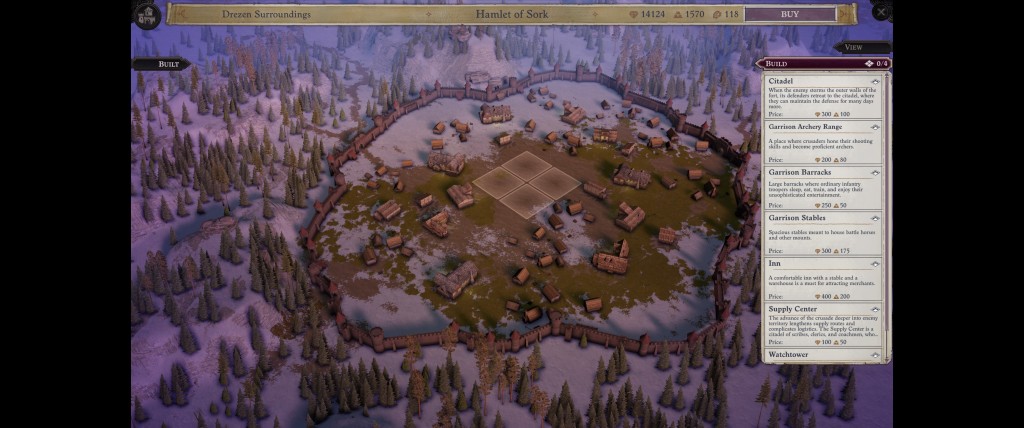
So, I turned on the automatic Crusades mode, which can’t be changed back, and never looked back. Free of the burdens of command I could get back to looking in every barrel I came across in case it was somehow hiding a Battle Axe of Being a Badass +10. At no point was a barrel actually hiding such a thing, but it could have been, and that little, tiny possibility meant that I absolutely had to check them all.
Another way Wrath of the Righteous can be problematic is how it handles difficulty. There are numerous times when you’ll come across an enemy with such an absurdly high AC and a bunch of other buffs and abilities that make them impossible to hit and resistant to every spell and ability. You can spend round after round vainly attacking them, only to be obliterated because they also have about six attacks that take down your tank in a single round. But then just one room to the side you’ll find the big boss of the mission and mow them down in a couple of rounds. It’s more uneven than a scoliosis sufferers spine, and Owlcat’s heavy reliance of giving enemies obscene abilities to dodge attacks can lead to a lot of tedium. If you spec towards some specific builds you combat this a little, but even then it’s difficulty design at its more basic and boring, the equivalent of just giving an enemy more and more hitpoints in other games.
Keep in mind, what I’m talking about is different from other areas of the game where you simply need to come back later once you’ve build your party up more. Wintersun is a prime example, a location you can get to quite early in Act 3 that will stomp the soul out of your mangled corpse and then use your limbs as stirring spoons. It’s a hell of a wall and a deadly trap for players who stumble into it.
As for bugs and glitches, the first few chapters were nearly flawless but toward the latter half of the game more started to appear. On the less impactful end of the spectrum I ran into instances of the Charge ability not working correctly or characters failing to do what they were told. On the bigger end, I had a few crashes, characters getting stuck, triggers not working correctly and more. The closest to game breaking was a fight where all but two of my party members got locked out of a fight, and restarting didn’t help. However, Owlcat did manage to fix the vast majority of issues with their prior game, so I’m reasonably confident Wrath of the Righteous will be patched.
Pathfinder: Wrath of the Righteous is a life-consuming adventure set in a rich fantasy world. This is the kind of game where you need to devote serious time and even research to. You could spend hours watching tutorials and reading guides only to fire up the game and still feel overwhelmed by the character creation system alone. It’s size and complexity do bring with it some issues, and for some the Crusades mode might be a real slog unless they disable it. For many those issues will be well worth the trade-off, and the extra gameplay that Crusade mode adds will be most welcome. If you have the time and patience for a game of this scope, Pathfinder: Wrath of the Righteous is a richly rewarding, uncompromising, meaty experience that isn’t interested in being for everyone. In an era where big games want to appeal to the widest audiences, it’s refreshing and encouraging to see titles like Pathfidner: Wrath of the Righteous that know their audience and seeks to give them the experience they want and deserve.
